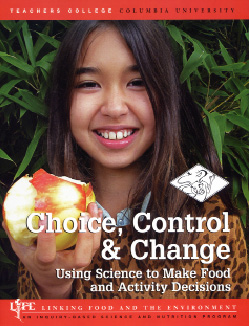Eat, Play, Live
An updated curriculum on healthy choices
You and your friends walk down the street and smell hot, delicious French fries. You remember the last time you ate some, they were crisp and covered with salt.
So begins “French Fry Visualization,” an exercise from Choice, Control and Change: Using Science to Make Food and Activity Decisions, by Pamela Koch, Executive Director of TC’s Center for Food & Environment and co-authors Isobel Contento, TC’s Mary Swartz Rose Professor of Nutrition and Education, and Angela Barton of Michigan State University. Jointly released by TC and the National Garden Association, the book (a curriculum for middle-school teachers), encourages students to think carefully about their daily food choices.
Choice, Control and Change (also known as C3 curriculum) is the third book of the LiFE (Linking Food and the Environment) curriculum series, a collaboration between TC’s Science Education and Nutrition Education programs. With 25 million overweight or obese U.S. youth, LiFE supports “scientific habits of mind” that will integrate the study of food, food systems and environmental and personal health.
C3 “takes the stance that to change students’ food and activity choices, we need to focus on concrete behaviors that make sense in the context of their lives,” the authors write.
C3 positions teachers as partners who join students in seeking answers. If a student asks, “How does my body use energy from food?” the C3 response would be, “Well, how shall we find out?” The underlying message: knowing how to find an answer is as important as knowing the answer itself.
All exercises are rooted in scientific inquiry and, often, media literacy. In an exercise about a radio ad in which athletes endorse a new energy drink, students are encouraged to question the ad’s claims. Does the drink really provide energy? Where might one go to learn what’s in the drink?
The book also covers key biological concepts, such as metabolism and the digestive system. Students learn that it takes 2,000 steps to burn 100 calories and that they should take at least 10,000 steps daily. They are given pedometers to log their own daily step counts, as well as the conceptual tools to assess opportunities for physical activity in their schools. C3 also emphasizes the complex causes of the obesity epidemic, highlighting nationwide increases in portion sizes and time spent playing video games, as well as the heavy marketing of less-than-healthy foods. Students are encouraged to look at the larger systems that frame their own choices.
In 10 New York City middle schools, students who received C3 reported drinking fewer sweetened beverages, eating fewer processed packaged snacks, such as chips and candy, and engaging in increased “purposeful walking” and decreased leisure “screen time.” Those results will be published in the Journal of the American Dietetic Association in December 2010.
“We hope students can use what they learn in C3 to better navigate through our current food and activity environments,” Koch says. “We want them to make choices that will help them take control and changes that will allow them to reach their maximum potential now and remain healthy into the future.”
The development, evaluation and publication of C3 were made possible by a Science Education Partnership Award grant from the National Center for Research Resources, a component of the National Institutes of Health. Additional funding came from the W. K. Kellogg Foundation.
Published Monday, Nov. 22, 2010
